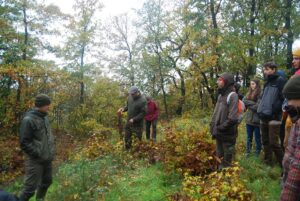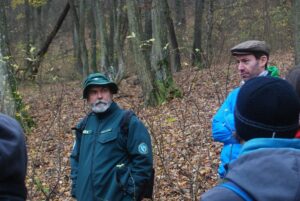In the CLIMAFORCEELIFE project, the students of the University of Sopron took part in a study trip from 4 November to 6 November 2022 organized by WWF Hungary and the Kaán Károly Ökoklub. The topic of the study trip was “Climate adaptation opportunities in the Central-Eastern European region“. The trip which was led by Pál Bódis, forest engineer, project coordinator of the WWF Hungary’s Forest Program, put special focus on the increase of biological diversity and climate adaptation.
The first stop of the study trip was in the Bakony Mountains where the group visited the oak forests of Sándor Siffer who manages his forests together with his sons using selective cutting method. Dávid Sütő, ecologist and scientific associate at WWF presented his research on the impact of wildlife in the area.
The next stop of the field program was the Balaton-felvidék National Park Directorate’s forest area in Koloska Valley which was introduced by landscape unit manager József Vers. Taking advantage of the terrain conditions of the different parts of the forest, canopy gaps have been opened, leaving out certain groups of trees. The expansion of the canopy gaps is achieved by girdling the trees and their subsequent destruction, thereby promoting the renewal of their forests and the expansion of their habitat stock. Timber harvested in the area is left in the forest in order to expand the range of habitat and structural diversity of the forest.
The participants spent the second day of the field trip in the Danube Bend. First, the students visited the Kosd forest of private forest owner, Gábor Flamich where together with Gábor Tímár they introduced the climate adaptation options of private forest owners. The forest areas of Kosd are mostly managed in a transitional mode – a method between cutting method and continuous cover forest management methods. In order to preserve the forest climate, the maintenance of continuous forest cover is also an important option, considering future forest management. In its forest areas, Gábor Flamich has also carried out structural transformations of non-native black locust forests by changing tree species, during which these forests are transformed into native, oak-dominant deciduous forests.
At the end of the study trip, the students, guided by Zsolt Barton and forest ecologist, Tibor Standovár, visited the beech-oak deciduous forest of Mogyorósi-lapos, where deciduous, evergreen forest management is practiced then the “Beautiful forest” which is a 140 years old sessile oak forest managed with selective cutting.
Photo: Erik Vald















